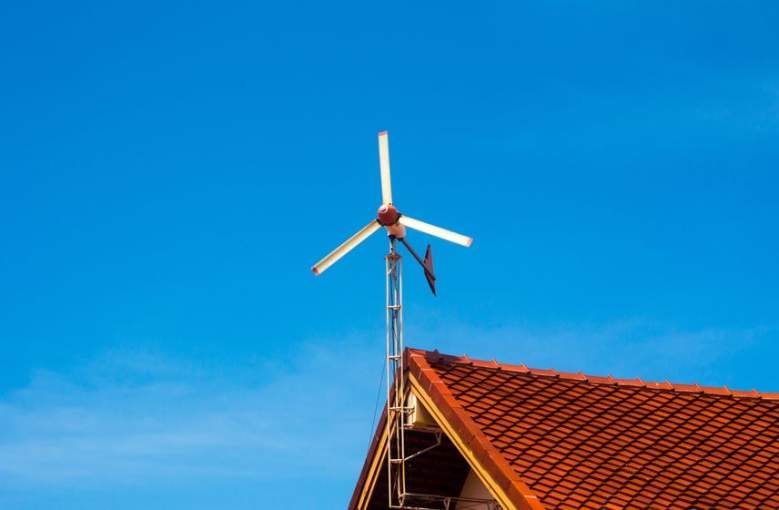
123RF.com (Wattana Tasanart)
If you happen to live in an area of the country blessed with a significant amount of wind for most of the year, consider a wind turbine generator. Installing one of these generators for your home may be a cost-effective means to lower electricity bills. They may also help to keep power supplies uninterrupted if and when an outage occurs.
Like solar panels, wind power generators can be excellent, home-based, renewable, energy systems with absolutely zero emissions and pollution. Small wind electric systems can also be used for a variety of other applications for farms and ranches. That’s handy since existing mainstream power supplies could be miles away.
There is a lot to consider before installing a wind power generator at your house. But once you do the homework and consider all the variables you have to work with, a wind turbine for home use may be just the thing you need to lower your energy bills. Below, find the best wind turbine for home use in 2022:

|
Amazon Customer Reviews
|
Price: $4,868.59 Shop at Amazon | Shop now Read our review |
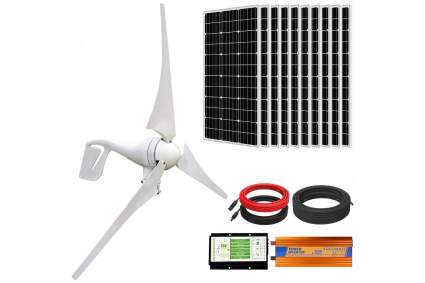
|
Amazon Customer Reviews
|
Price: $1,892.99 Shop at Amazon | Shop now Read our review |
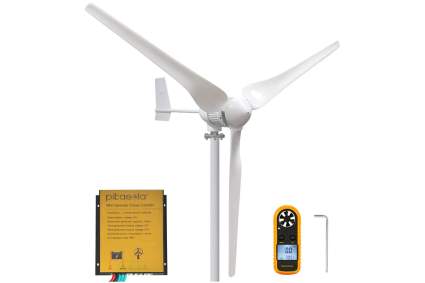
|
Amazon Customer Reviews
|
Price: $799.99 Shop at Amazon | Shop now Read our review |
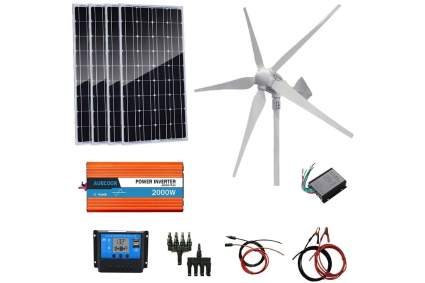
|
Amazon Customer Reviews
|
Price: $1,589.85 Shop at Amazon | Shop now Read our review |
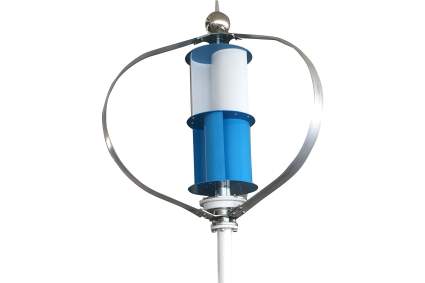
|
Amazon Customer Reviews
|
Price: $1,299.00 Shop at Amazon | Shop now Read our review |
-
1. Giosolar 3,000W 48V Hybrid Solar Wind Backup Power Kit
Pros:- Wind and solar hybrid kit
- Five-bladed turbine
- Includes battery and inverter
Cons:- More of a power kit for travel than home
- Does not include tower for the wind turbine
- Expensive
This 3,000 Watt 48V Hybrid Solar and Wind Backup Power Kit from Giosolar is less of a home turbine kit than it is an assembly to generate power for remote areas. Good for both residential and commercial use, the 1,000W wind turbine can provide power throughout the day and night, combined with solar panels to augment the charging capabilities of the battery.
The wind turbine generator has five blades rather than the typical three. Starting wind speed can be as low as 2-1/2 meters per second in order to collect electricity. The kit is easy to assemble, features low noise during operation, and is sealed to keep the elements out of the turbine housing.
On the other side, the ETFE flexible solar panel is made of a tough material with a 23.5% efficiency. The panel can be flexed to a maximum of 30 degrees for flush mounting to curved surfaces like the roof of an RV, a boat, camper, tents, or other vehicles.
Other equipment includes a 40A 48 Volt Maximum Power Point Tracking (MPPT) photovoltaic (PV) battery charge controller and a 3,000 Watt Pure Sine Wave Power Inverter with several protection modes: overload, high temp, high and low voltage, short circuit, and more.
Find more Giosolar 3,000W 48V Hybrid Backup Power Kit information and reviews here.
-
2. Eco-Worthy 1,400W Wind Solar Power Kit
Pros:- Carbon fiber composite construction
- 2000 W electrical capability depending on wind availability
- Kit comes with controller, inverter, and a solar panel
Cons:- Doesn't include tower
- Doesn't include wiring
- Doesn't include battery
This 1,400W Wind Solar Power Kit from Eco-Worthy includes a number of crucial components in order to get your wind turbine operation up and running. The wind turbine generator features three wide 24-inch long blades making for a slightly larger than four-foot diameter. The blades and housing are made of a carbon fiber composite material for excellent durability against inclement weather.
A 24V wind and solar hybrid controller is included in the kit and is rated at an 800 Watt capacity from the wind turbine and 1,000 Watts with the solar panel. The inverter works off from 24V DC power and converts to standard 110V AC electricity. Solar and wind kits seem to be a thing and this kit indeed features a 100 Watt, 12 Volt solar panel that measures roughly 40 inches by 20 inches and is about 1-1/2 inches thick.
Find more Eco-Worthy 1,400W Wind Solar Power Kit information and reviews here.
-
3. Pikasola 1000W 24V Wind Turbine Generator Kit
Pros:- Three-phase permanent magnet synchronous motor
- Almost 48-inch long fan blades
- Includes charge controller
Cons:- Battery is an additional cost
- Tower is extra
- One to two week shipping requirement
This Pikasola 1000W 24V Wind Turbine Generator Kit looks good and is of high quality but isn’t a kit, really, but more of a super component package to anchor whatever wind turbine for home system you’re dreaming up. The wind turbine itself works off of a horizontal axis, parallel to the ground.
The components are made of a nylon/carbon fiber material with an approximately 48-inch blade length. The material is waterproof, corrosion-resistant, and lightweight. The turbine generator features a three-phase permanent magnet synchronous motor. The fully integrated voltage regulator automatically shuts down when the battery is fully charged.
The unit has a rotating body with a yaw adjustment system so it positions itself automatically according to the wind direction. The turbine only needs 2-1/2 meters per second wind speed to begin producing energy which is nice.
Find more Pikasola 1000W 24V Wind Turbine Generator Kit information and reviews here.
-
4. Auecoor 1,200 Watt Wind and Solar Power Kit
Pros:- Six-foot total fan diameter
- Three meter per second start speed
- 800 Watt capacity
Cons:- Battery is additional cost
- So is any sort of tower
- The turbine seems to play a lesser role than the solar panels
The Auecoor 1,200 Watt Wind and Solar Power Kit features a solar panel designed to withstand high wind and snow loads and features weather-resistant exterior durability. The frame is made of aluminum so it’s naturally corrosion-resistant as well. Conversion efficiency can rise to more than 20% and performs well in low-light environments.
The included inverter is a pure sine wave model for faster and sensitive operation. It features good electrical protection and has an aluminum alloy housing so it too won’t rust and resists heat. The kit also comes with some alligator clips and two controllers, one for the panels and one for the turbine.
Speaking of which: how does this wind turbine measure up? The unit itself is capable of 800 Watts and features five blades measuring a little over six feet in diameter. Start-up speed for power generation is a reasonable three meters per second as well. The turbine has a three-phase permanent magnet generator and the materials seem to be of high quality.
Find more Auecoor 1,200 Watt Wind and Solar Power Kit information and reviews here.
-
5. Tumo-Int 400W Vertical Wind Turbine Generator Kit with Controller
Pros:- Visually stimulating
- Uses a vertical axis for operation
- Made of aluminum alloy so it's light and durable
Cons:- Literally includes just the turbine and a controller
- Expensive
- Long lead time for delivery
The Tumo-Int 400W Vertical Wind Turbine Generator is the only unit on our list that utilizes a vertical axis. The wind power generator looks and functions like a visually pleasing home decor item and I think that’s sort of the point. The vendor, Tumo-Int, provides many photos of this wind turbine in various locations including the tops of street lights, the apex of rooflines, and as part of a colorful garden environment.
Both visually stimulating and useful, this wind turbine generator doesn’t provide as much electricity as some of the other models on our list. What it does, however, is provide a point of interest for landscape and skyline. The main cylinder is made up of curved scoops, three on top of three, that catch the wind along with two curved fan blades that assist in harvest lift from air currents.
An electric controller is included with each unit, but that’s it. Unfortunately, everything else will need to be acquired separately from this wind turbine. That’s a pity because this generator is clearly the most interesting of the entire list. Still, it’s a great option for anyone with a bit of creative style.
Find more Tumo-Int 400W Vertical Wind Turbine Generator information and reviews here.
How Does a Wind Turbine Work?
Have you seen those enormous white pinwheel-type fans grouped together across the landscape while driving around the country? Along with industrial-grade solar panel arrays, wind turbine generators are becoming more common as utility companies turn away from the burning of fossil fuels. Wind power is clean and has been used by humans to power machines for thousands of years.
But wind turbine equipment isn't just for power companies. Wind power generators are available for single home use as well. Wind is plentiful and the adoption rate of using it to generate electricity has increased by a factor of 24 since the year 2000.
You’re most likely familiar with how a wind turbine works already. The most typical design of a commercial-grade wind turbine centers around three blades mounted to a tall steel tower. These towers reach 100 feet or more up from the ground to take advantage of faster wind speeds found at that height.
Lift and drag are aerodynamic forces that allow wind turbines to work. When the wind passes by the turbine, a pocket of low-pressure air forms on one side of the blade. That pocket pulls each blade towards it and the rotor turns. That’s called lift. The force of the wind on the face of the blade is called drag.
The shape of the blade is such that the lift is stronger than the drag. The blades turn the rotor and the entire assembly is like a propeller. Inside the turbine is a series of gears to efficiently increase the rotation of the rotor by a factor of one hundred. That high rotation ratio allows the generator to produce AC electricity.
How Does a Wind Turbine for Home Use Work?
A wind turbine for home use is made up of a small wind generator mounted on a tower to take advantage of stronger winds at a higher altitude. Let’s go over the basic components of a home-based wind turbine system below:
Turbines. Most small wind turbines manufactured today are like what you see used in large wind farms across the country: a machine atop a tall tower that utilizes a horizontal axis for three blades to spin a rotor. Instead of steel, blades for home-based units are usually made of a composite material like fiberglass.
The frame of the turbine is what the other parts of the unit are attached to. The amount of energy a turbine will produce depends primarily on the diameter of the rotor. The diameter of the rotor defines what quantity of wind can be captured by the turbine. A tail on the opposite side of the blades keeps the turbine facing into the wind.
Towers. As stated above, wind speeds increase with height. That means that the best chance of operating a successful wind turbine generator is to mount the system on a tower. The higher the tower, the more power the wind system can usually produce.
It doesn’t take much expense or effort to increase the tower height related to how much power can be generated. Check this out: raising a 10-kilowatt generator from 60 feet to 100 feet high may cost 10% more overall but it could produce 25% more power.
But here’s the thing: towers can be tricky to install. You’re dealing with a tall piece of equipment that must be secured effectively. When you shop around for a wind turbine kit for yourself, you’ll find that most of them will include a tower for you to build.
You’ll discover that there are two types of towers for home installation: free-standing varieties that are self-supporting and guyed. Guyed towers are the most common, are less expensive and easier to install than self-supporting towers. Here’s the trick, however: the radius for the guy wires must be one-half to three-quarters of the tower height so you’ll need enough space to accommodate all the equipment.
Before you pass on a self-supporting tower, consider the fact that they offer a simple method to perform maintenance on the turbine. Some self-supporting towers feature a tilt-down feature that allows the turbine to be lowered to the ground in the case of hazardous weather such as hurricanes.
Something else to consider is that a wind turbine for home use is usually installed close to where the generated electricity will be used. Small home turbines can be found connected to diesel generators and battery systems. Hybrid systems like this can be found most often on farms and ranches and other remote locations where a connection to a utility grid is not available.
Everything Else. In addition to the turbine and the tower, you’ll need to look at what you’re installing a wind turbine for home for. The components necessary for a successful installation will depend on what you need the turbine to do. Powering a battery will require different parts than a water pumping system.
You’ll also need to consider if your wind electrical system will be connected to the residential power grid, wholly separate from a grid, or a combination. Equipment vendors will typically be able to provide you with an all-in package that includes what you need for your particular application.
So let’s say you’re looking for a wind power generator for your house that will supplement your existing energy grid. You may need a controller, storage batteries, an inverter for conditioning power, wiring, an electrical disconnect switch, grounding system, and a foundation for the tower.
Is a Wind Turbine for Home Use Worth It?
There’s a lot to consider when looking at investing in a wind turbine generator. The large commercial models are so much larger than anything available for home-based use that comparing the two isn’t a possibility.
A wind turbine for home use will understandably work best in areas that feature an abundance of higher wind speeds. The greater height that a wind turbine can operate, the better. It also makes sense that a house in a rural setting without many obstructions will provide a wind power generator more opportunity than a dense suburban neighborhood.
So is a wind turbine for home use worth it? The answer to that question is purely subjective depending on a user’s needs. It takes a significant amount of planning and homework to determine some key factors before diving right in.
Is there enough wind in my area that blows with consistent frequency? In order for a wind power generator to work at all, you will need to gauge the amount of reliable wind in your immediate area. Wind can vary significantly just a few miles because of terrain, obstructions, foliage, and more.
There are a few resources that you can take a look at to get a better understanding of what you may have to work with. Your local airport should be able to provide data for average wind speeds. Of course, airports are typically located at remote locations away from urban density. Keep in mind that airports measure wind at a height of 20 to 35 feet above the ground.
Wind resource maps are useful in finding high wind speeds by location. The US Department of Energy's WINDExchange has wind resource maps by state. The site also features useful information about wind power and the efforts taken around the country.
Perhaps one of the easiest ways of tracking how much wind you might have is to observe the trees around you and record a diary over time. Trees, especially evergreens, can be shaped by strong winds that are easy to witness.
Direct measurement through a wind resource system is possible but the equipment can cost around $1,000. It also must be set high enough for measuring accurately. Apart from that, there may be a local consumer group in your area that may have data already taken from installed home wind turbine systems.
The bottom line is that most suburban locations aren’t suitable for generating significant amounts of power derived from wind. Your location may experience periods of high gusts during storms and other extreme weather, but what you really need to make a wind turbine generator work well is a consistent amount of wind resources. Five meters per second is a good average.
How much power do I want to generate? Are you looking to take your home off the grid completely or do you simply wish to have a little natural help in lowering the energy bill? Take a look at your monthly utility bill to get a baseline number to start from. In addition, the US Department of Energy features an appliance energy calculator to help give you an idea of what you’ll need.
Talking to your local utility company is a great place to get firm data on the average number of kilowatts used annually at your home. They may also know customers that have installed wind turbine generators and can help with answering questions.
One thing is certain when estimating your energy needs for a wind turbine: manage your expectations. Unless you pick up a very large wind turbine generator and live in a windy area miles from anyone else, you will most likely not replace the energy supply your utility company can provide.
What is my budget for a wind turbine for home use setup? Like anything else, the cost of a wind turbine for home use depends on a wide range of factors. System size, the height of the tower, and the amount of equipment purchased all have a lot to do with the final tally. The more power the unit can produce will dictate a higher price overall.
An organization called the American Wind Energy Association estimates that wind turbines cost between $3,000 to $5,000 for every kilowatt of power capacity. Homeowners that depend on a wind power generator as the sole source of electricity install 15 kilowatts of wind power capacity. The math on that calculates a cost of up to $75,000.
Wind power generators like the ones on our list aren’t nearly that expensive or powerful, however they can definitely help toward relieving strain on your power bill each month. There may also be opportunities from your state or local government or utility companies in the form of rebates toward wind or solar equipment.
Does the zoning in my area accommodate a wind power generator? There are a lot of considerations to observe before moving forward with installing a wind turbine. Consider the height of your tower since most residential areas have a limit of 35 feet in the air.
Sound may also be an issue. When your blades spin the rotor, there will be a noise just louder than the wind noise, It’s typically not an issue but it’s something to consider.
Find out about potential zoning and neighborhood covenant issues before you pitch out a lot of money on a wind power generator. Contact the local building inspector, board of supervisors, or planning board in your immediate area. They can tell you if you will need to obtain a building permit and provide you with a list of requirements.
Then there are the other things to consider with a homeowners' association: will your tower block anyone’s view? Will your neighbors be unreasonable about whatever ambient noise the turbine might make?
Do your homework, consider the variables you have to work with, and then you can make a decision. The wind turbine generator you decide upon may not be enough to power your house, but it could make a serious dent in your monthly power bill.
See Also: